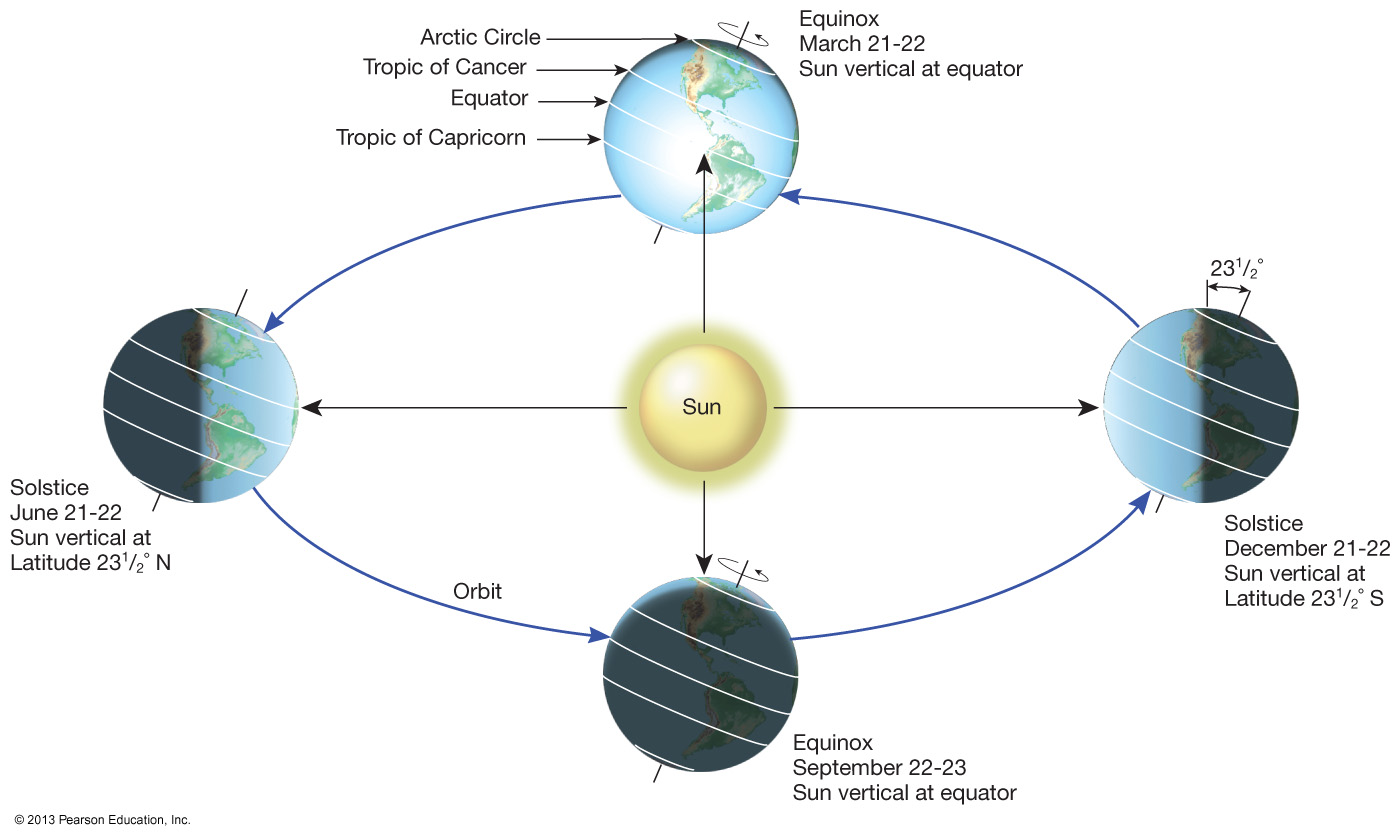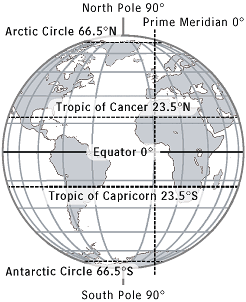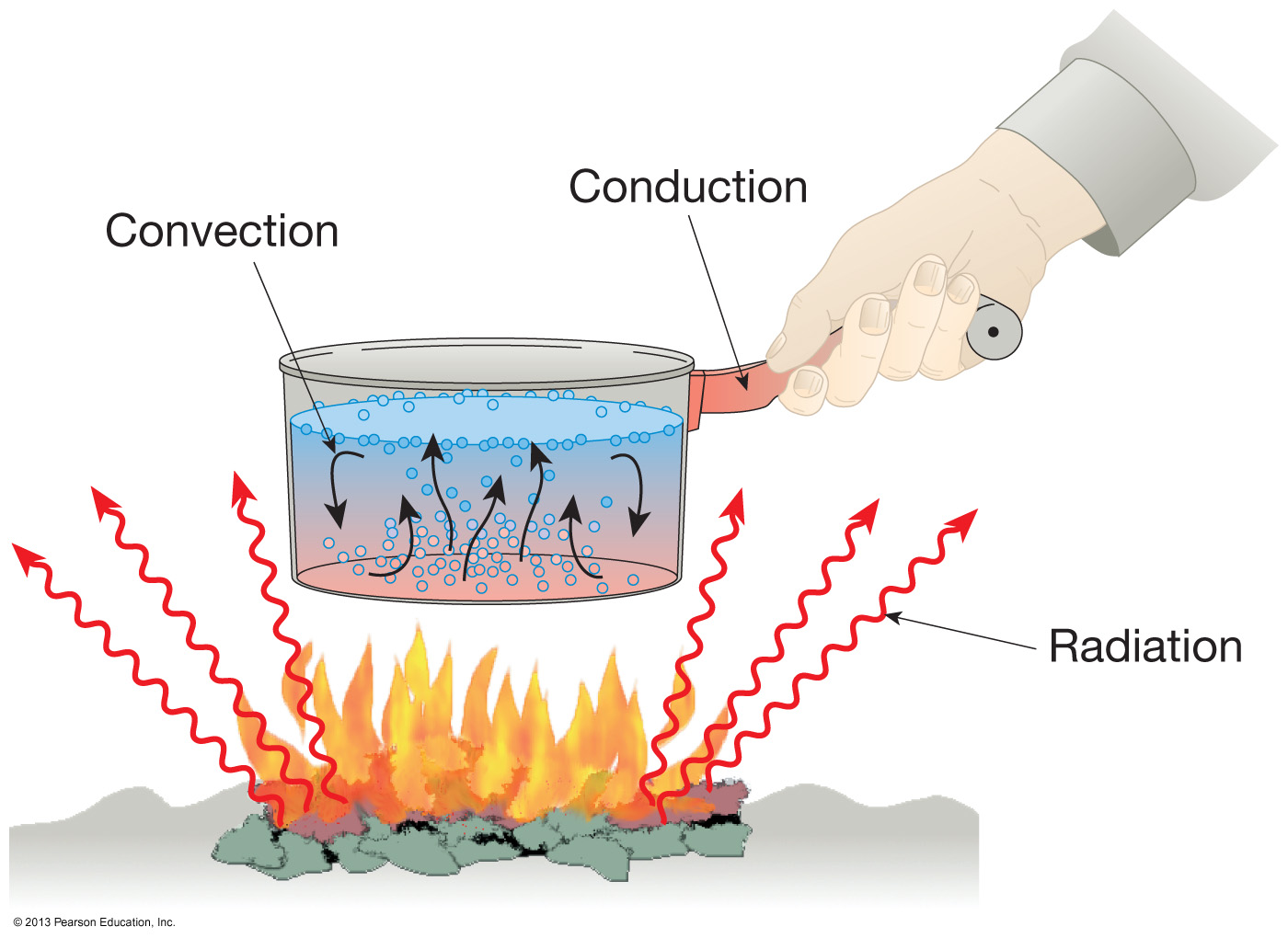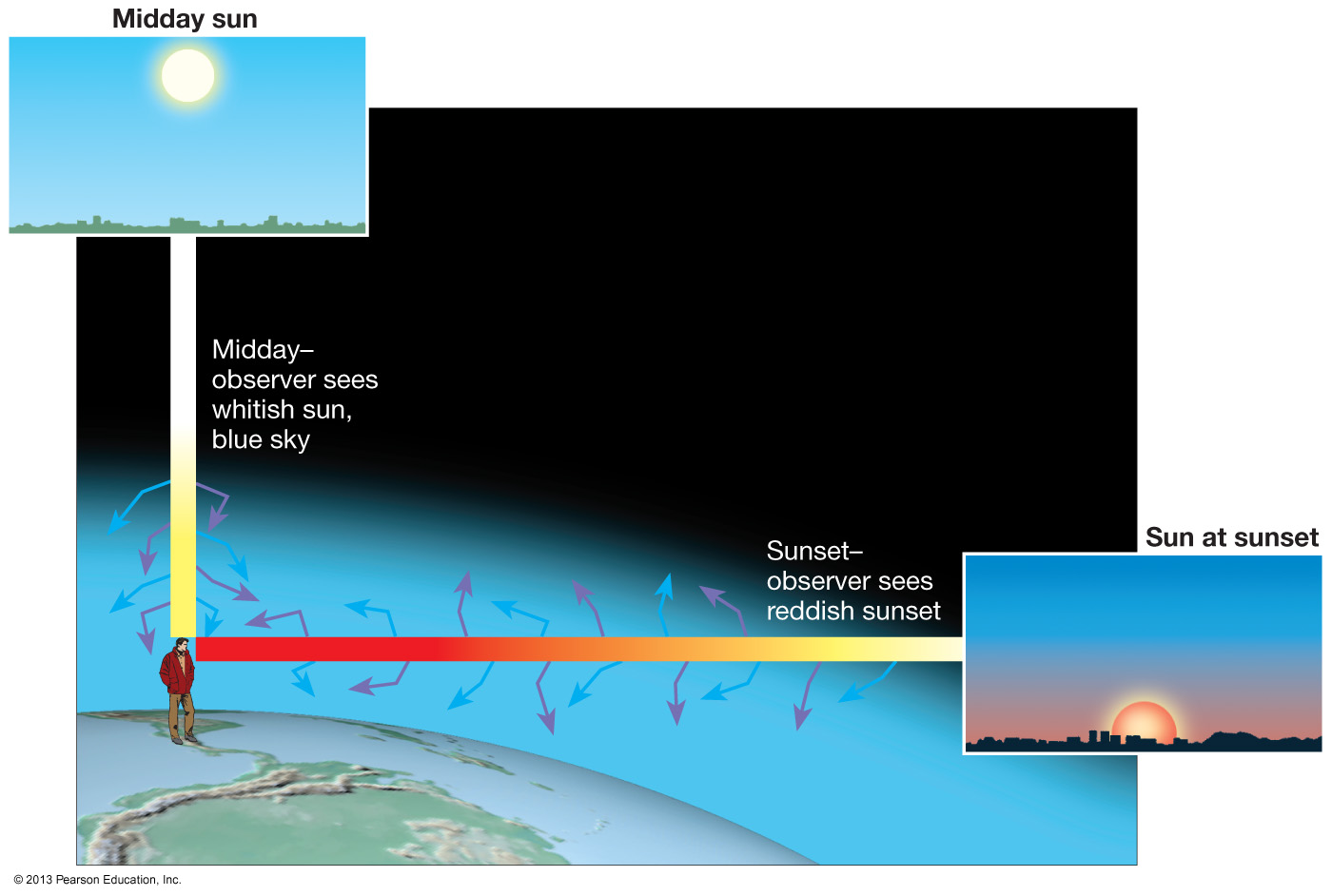
NOTICE THE TILT OF THE EARTH AND THE LOCATION THE SUN'S RAYS ARE HITTING
CHAPTER 1 and CHAPTER 2 - TEST 1 - SEPTEMBER 15TH 2025
Watch the Below videos..
Earth has two principal motions: rotation and revolution. Rotation
is the spinning of Earth about its axis. Revolution refers to the movement of
Earth in its orbit around the Sun.
The two most important reasons for the variation in solar energy reaching a particular location are:
1. The seasonal changes in the angle at which the Sun's rays strike the surface
2. The length of daylight.
The four days each year given special significance based on the annual migration
of the direct rays of the Sun and its importance to the yearly cycle of weather
are
(1) June 20-22, the summer solstice for people living in the Northern Hemisphere,
when the vertical rays of the Sun are striking 23.5° north latitude (Tropic
of Cancer)
(2) December 20-22, the winter solstice for people living in the
Northern Hemisphere, when the vertical rays of the Sun are striking 23.5° south
latitude (Tropic of Capricorn)
(3) September 21-23, the autumnal equinox in
the Northern Hemisphere, when the vertical rays of the Sun strike the equator
(4) March 19-22, the spring or vernal, equinox in the Northern Hemisphere,
when the vertical rays of the Sun also strike the equator.
Important pages and Smart figures Pages 29-34, Figures: 2.2,
2.5, 2.6, 2.9

NOTICE THE TILT OF THE EARTH AND THE LOCATION THE SUN'S RAYS ARE HITTING
Very important-- notice where the sun's rays are hitting the earth during the seasons.
What latitude lines are important, and how much daylight suring the season?.
UNDERSTANDING SUN ANGLE -
1. What will be the noon sun angle on June 21 in Farmingdale, NY? Assume that Farmingdale,NY is at 40 degrees North
a) Where is the sun directly overhead: 23.5 deg N
b) What is the latitude that separates the two locations:
40 deg N - 23.5 deg N = 16.5 deg
c) What is the noon sun angle
90 - 16.5 = 73.5 deg
Note this will be the maximum altitude of the sun in Farmingdale,NY.
2. What will be the noon sun angle on Dec 21 in Farmingdale, NY? Assume that Farmingdale,NY is at 40 degrees North.
a) Where is the sun directly overhead: 23.5 deg S
b) What is the latitude that separates the two locations:
40 deg N + 23.5 deg S = 63.5 deg
c) What is the noon sun angle
90 - 63.5 = 26.5 deg
Note this will be the minimum altitude of the sun in Farmingdale, NY.
Hint: Cancer comes before Capricorn

Know latittude lines.
Figure 1
C: March 19TH - 22ND Spring or Vernal Equinox - About 12 hours of daylight
D: Summer Solstice June 20TH - 22ND, About 15 hours of daylight
B: Autumnal Equinox September 21ST - 23RD - About 12 hours of daylight
A: Winter Solstice December 20TH - 22ND, About 9 hours of daylight
Figure 2
C: 66 1/2 Degrees North: Arctic Cirle
E: 23 1/2 Degrees North: Tropic of Cancer
B: 0 Degrees: Equator
A: 23 1/2 Degrees South: Tropic of Capricorn
D: 66 1/2 Degrees South: Antarctic Circle
DAYLIGHT SAVING TIME -
Daylight saving time (2025)
Sunday, March 9th, 2025 2:00 AM - Sunday, November 2, 2025 2:00 AM
CLOCKS MOVE FORWARD ONE HOUR MARCH 9, 2AM TO 3AM.
SUNRISE: 7:13AM - SUNSET: 6:53PM
Monthly Almanacs
Daily climatological data can be analyzed to produce averages and records. This information is included in our monthly almanacs.
The almanacs also contain times of sunrise and sunset times and daily records of precipitation and snowfall.
The First Days of the Seasons
| 2025 Seasons | Astronomical Start | Meteorological Start |
|---|---|---|
| SPRING | Thursday, March 20, 5:01 P.M. EDT | Saturday, March 1 |
| SUMMER | Friday, June 20, 10:42 P.M. EDT | Sunday, June 1 |
| FALL | Monday, September 22, 2:19 P.M. EDT | Monday, September 1 |
| WINTER | Sunday, December 21, 10:03 A.M. EST | Monday, December 1 |
Note: The dates above correspond to the start of the listed seasons in the Northern Hemisphere. Times are based on Eastern time (ET). Subtract 3 hours for Pacific time, 2 hours for Mountain time, 1 hour for Central time, and so on.
Why Do the Seasons Change?
From http://www.almanac.com/content/first-day-seasons
The four seasons are determined by shifting sunlight (not heat!)—which is determined by how our planet orbits the Sun and the tilt of its axis.
On the vernal equinox, day and night are each approximately 12 hours long (with the actual time of equal day and night, in the Northern Hemisphere, occurring a few days before the vernal equinox). The Sun crosses the celestial equator going northward; it rises exactly due east and sets exactly due west. See our First Day of Spring page!
On the summer solstice, we enjoy the most daylight of the calendar year. The Sun reaches its most northern point in the sky at local noon. After this date, the days start getting “shorter,” i.e., the length of daylight starts to decrease. See our First Day of Summer page!
On the autumnal equinox, day and night are each about 12 hours long (with the actual time of equal day and night, in the Northern Hemisphere, occurring a few days after the autumnal equinox). The Sun crosses the celestial equator going southward; it rises exactly due east and sets exactly due west. See our First Day of Fall page!
The winter solstice is the “shortest day” of the year, meaning the least amount of sunflight; the Sun reaches its most southern point in the sky at local noon. After this date, the days start getting “longer,” i.e., the amount of daylight begins to increase See our First Day of Winter page!
Energy is the ability to do work. The two major categories of energy are (1) kinetic energy, which can be thought of as energy of motion, and (2) potential energy, energy that has the capability to do work.
Heat is the transfer of energy into or out of an object because of temperature
differences between that object and its surroundings. (Read Pages 35-38)
What is the Difference Between Heat and Temperature.

The three mechanisms of heat transfer are ( Smart Figure 2.11 Page 37)
(1) conduction, the transfer of heat through matter by molecular activity.
(2)
convection, the transfer of heat by mass movement or circulation within a substance.
(3) radiation, the transfer mechanism by which solar energy reaches our
planet.
Radiation or electromagnetic radiation, whether X-rays, visible light, heat
waves, or radio, travels as various size waves through the vacuum of space at
300,000 kilometers per second. Shorter wavelengths of radiation are associated
with greater energy. The wavelength of visible light ranges from 0.4 micrometer
(violet) to 0.7 micrometer (red). Although the Sun emits many forms of radiation,
most of the energy is concentrated in the visible and near visible (infrared
and ultraviolet) parts of the spectrum.
The basic laws of radiation are:
(1)
all objects emit radiant energy,
(2) hotter objects radiate more total energy
per unit area than colder objects.
(3) the hotter the radiating body, the shorter
is the wavelength of maximum radiation.
(4) objects that are good absorbers
of radiation are also good emitters.
Satellite Views: Visible
and Infrared
Smart Figure 2.13 Page 38

Important pages and Smart figures Pages 42-48, Figures: 2.15,
2.16, 2.17, 2.18
Approximately 50 percent of the solar energy that strikes the top of the atmosphere reaches Earth's surface. About 30 percent is reflected back to space by the atmosphere. The remaining 20 percent of the energy is absorbed by clouds and the atmosphere's gases. The wavelength of the energy being transmitted, as well as the size and nature of the absorbing or reflecting substance, determine whether solar radiation will be scattered, reflected back to space, or absorbed. The fraction of radiation reflected by a surface is called its albedo. Fresh Snow has the highest Albedo.
Radiant energy that is absorbed heats Earth and eventually is reradiated skyward. Because Earth has a much lower surface temperature than the Sun, its radiation is in the form of longwave infrared radiation. Because the atmospheric gases, primarily water vapor and carbon dioxide, are more efficient absorbers of terrestrial (longwave) radiation, the atmosphere is heated from the ground up. **********The general drop in temperature with increased altitude in the troposphere (about 6.5°C/kilometer, a figure called the normal lapse rate) supports the fact that the atmosphere is heated from below.**** The transmission of shortwave solar radiation by the atmosphere, coupled with the selective absorption of terrestrial radiation by atmospheric gases that results in the warming of the atmosphere, is referred to as the greenhouse effect. Temperature is the average kenetic energy of the atoms in a substance. What is the difference between heat and temperature.
Because of the annual balance that exists between incoming and outgoing radiation, called Earth's heat budget, (Smartfigure 2.23, 2.24, Page 47,48) Earth's average temperature remains relatively constant, despite seasonal cold spells and heat waves.
Although the balance of incoming and outgoing radiation holds for the entire planet, it is not maintained at each latitude. Averaged over the entire year, a zone around Earth between 38°N and 38°S receives more solar radiation than is lost to space. The opposite is true for higher latitudes, where more heat is lost through longwave terrestrial radiation than is received. It is this energy imbalance between the low and high latitudes that drives the global winds and ocean currents, which in turn transfer surplus heat from the tropics poleward. Furthermore, the radiation balance of a given place fluctuates with changes in cloud cover, atmospheric composition, and most important, Sun angle and length of daylight. Thus, areas of radiation surplus and deficit migrate seasonally as the Sun angle and length of daylight change.
FOR TEST---CHAPTER 1 and CHAPTER 2 - TEST 1 - -TEST 1 - SEPTEMBER 15TH 2025
Don't forget you MUST read the chapters in the Book!!!! AGAIN - YOU MUST READ THE CHAPTERS IN THE BOOK.
Below is a recap of Chapter One and Chapter Two.
Some of the main topics on Test 1 --email me if you have any questions - richard.hoffman@farmingdale.edu
Know levels of the atmosphere. What is important about each level, what makes one different from the next? Air, Temperature, Gases and Location.
Climate and Weather - They are different. Why and How. Almanac gives an idea of the climate of the Area.
Seasons - Why do we have seasons? Where do they sun's rays hit the Earth? How much radiation do we receive? What are the dates of the seasons? How much daylight
does Long Island see during the different
seasons? What is important about Tropic of Cancer, Equator and Tropic of Capricorn?
Three heat transfers. Page 37.
Difference between heat and temperature.
Why is the sunsets red and sky blue?
Albedo
Wavelengths
TEST 1 - Chapter 1 / Chapter 2 ---CHAPTER 1 and CHAPTER 2 - TEST 1 - SEPTEMBER 15TH 2025
DID YOU WATCH THE BELOW VIDEO?